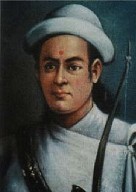Shree Captain Later General balbhadra Kunwar | |
|---|---|
| श्री कप्तान पछि जेनरल बलभद्र कुँवर | |
 Young Balbhadra Kunwar around Anglo-Nepal war | |
| Personal details | |
| Born | 30 January 1789 Bhanwarkot, Kavre, Gorkha Empire (present-day Bhanwarkot, Panchkhal Kavrepalanchok District, Nepal) |
| Died | 13 March 1823 (aged 34) Nowshera, Sikh Empire (present-day Nowshera, Khyber Pakhtunkhwa, Pakistan) |
| Parents |
|
| Relatives | see Kunwar family see Family of Amar Singh Thapa see Rana dynasty |
| Awards | National heroes of Nepal (posthumous) |
| Military service | |
| Allegiance | |
| Rank | Captain (Nepali convention) |
| Battles/wars | Anglo-Nepalese War |
Balbhadra Kunwar Chhetri (30 January 1789 – 13 March 1823)[1] was a Gorkhali military commander and administrator in the Kingdom of Nepal. He is one of the National heroes of Nepal.[2] He was highly praised for his military skill for the defence of Nalapani fort in the Anglo-Nepalese War (1814–1816).[3][4] He was a captain[5] in the Nepalese military and was tasked as commander to protect the forts of Dehradun.[6]
- ^ http://kathmandupost.ekantipur.com/printedition/news/2012-01-31/bulbudder-and-the-british.html
- ^ "National heroes of Nepal". 23 December 2011. Retrieved 2017-04-01.
- ^ Acharya 1971, p. 5.
- ^ "Nepalese Army | नेपाली सेना". Archived from the original on 2017-04-01. Retrieved 2017-04-01.
- ^ The use of English terms for their grades of command was common in the Nepalese army, but the powers of the different ranks did not correspond with those of the British system. The title of General was assumed by Bhimsen Thapa, as Commander-in-chief, and enjoyed by himself alone; of Colonels there were three or four only; all principal officers of the court, commanding more than one battalion. The title of Major was held by the adjutant of a battalion or independent company; and Captain was the next grade to colonel, implying the command of a corps. Luftun, or Lieutenant, was the style of the officers commanding companies under the Captain; and then followed the subaltern ranks of Soobadar, Jemadar, and Havildar, without any Ensigns. (Prinsep, p. 86-87)
- ^ Acharya, Jan. 1971.
